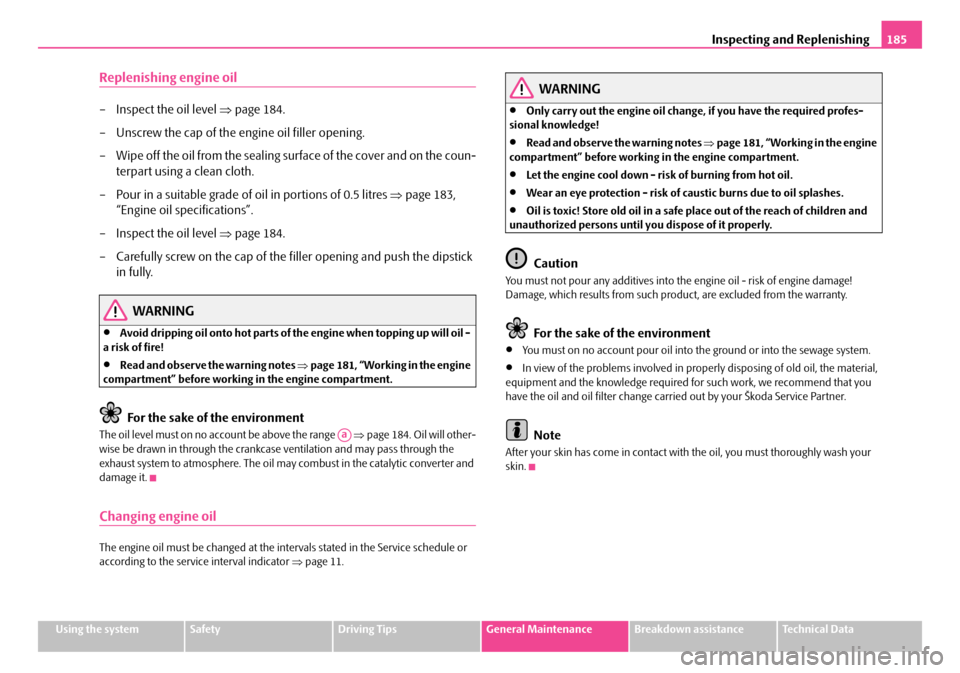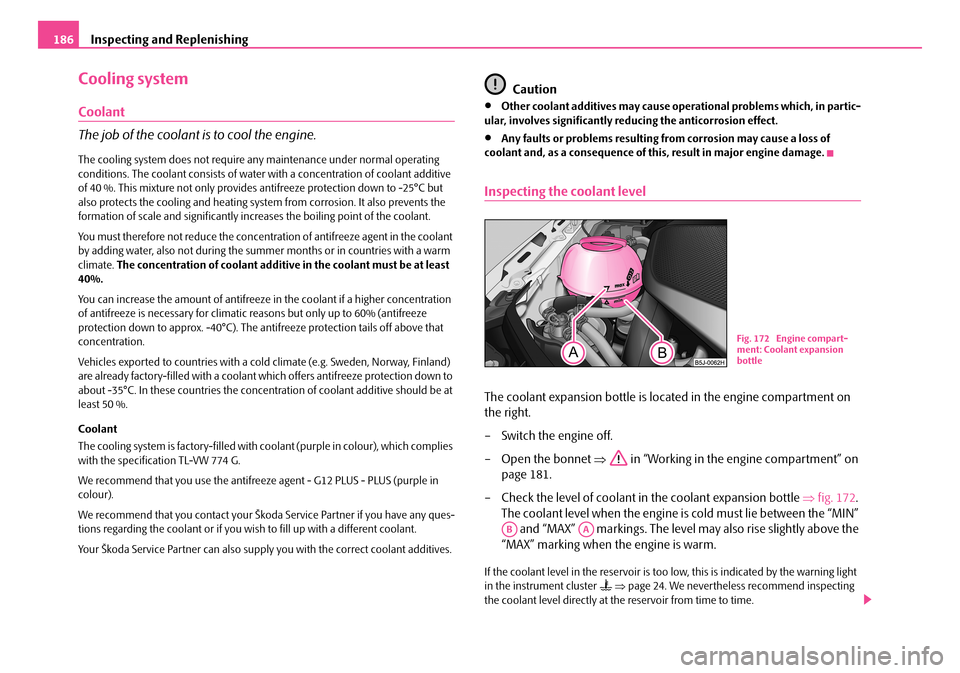oil additives SKODA FABIA 2008 2.G / 5J Owner's Manual
[x] Cancel search | Manufacturer: SKODA, Model Year: 2008, Model line: FABIA, Model: SKODA FABIA 2008 2.G / 5JPages: 252, PDF Size: 40.88 MB
Page 186 of 252

Inspecting and Replenishing185
Using the systemSafetyDriving TipsGeneral MaintenanceBreakdown assistanceTechnical Data
Replenishing engine oil
– Inspect the oil level ⇒page 184.
– Unscrew the cap of the engine oil filler opening.
– Wipe off the oil from the sealing surface of the cover and on the coun-
terpart using a clean cloth.
– Pour in a suitable grade of oil in portions of 0.5 litres ⇒page 183,
“Engine oil specifications”.
– Inspect the oil level ⇒page 184.
– Carefully screw on the cap of the filler opening and push the dipstick
in fully.
WARNING
•Avoid dripping oil onto hot parts of the engine when topping up will oil - a risk of fire!
•Read and observe the warning notes ⇒page 181, “Working in the engine compartment” before working in the engine compartment.
For the sake of the environment
The oil level must on no account be above the range ⇒page 184. Oil will other-wise be drawn in through the crankcase ventilation and may pass through the exhaust system to atmosphere. The oil may combust in the catalytic converter and damage it.
Changing engine oil
The engine oil must be changed at the intervals stated in the Service schedule or according to the service interval indicator ⇒page 11.
WARNING
•Only carry out the engine oil change, if you have the required profes-sional knowledge!
•Read and observe the warning notes ⇒page 181, “Working in the engine compartment” before working in the engine compartment.
•Let the engine cool down - risk of burning from hot oil.
•Wear an eye protection - risk of caustic burns due to oil splashes.
•Oil is toxic! Store old oil in a safe place out of the reach of children and unauthorized persons until you dispose of it properly.
Caution
You must not pour any additives into the engine oil - risk of engine damage! Damage, which results from such product, are excluded from the warranty.
For the sake of the environment
•You must on no account pour oil into the ground or into the sewage system.
•In view of the problems involved in properly disposing of old oil, the material, equipment and the knowledge required for such work, we recommend that you have the oil and oil filter change carried out by your Škoda Service Partner.
Note
After your skin has come in contact with the oil, you must thoroughly wash your skin.
Aa
NKO A05F 20.book Page 185 Wednesday, April 2, 2008 1:02 PM
Page 187 of 252

Inspecting and Replenishing186
Cooling system
Coolant
The job of the coolant is to cool the engine.
The cooling system does not require any maintenance under normal operating conditions. The coolant consists of water with a concentration of coolant additive of 40 %. This mixture not only provides antifreeze protection down to -25°C but also protects the cooling and heating system from corrosion. It also prevents the formation of scale and significantly increases the boiling point of the coolant.
You must therefore not reduce the concentration of antifreeze agent in the coolant by adding water, also not during the summer months or in countries with a warm climate. The concentration of coolant additive in the coolant must be at least 40%.
You can increase the amount of antifreeze in the coolant if a higher concentration of antifreeze is necessary for climatic reasons but only up to 60% (antifreeze protection down to approx. -40°C). The antifreeze protection tails off above that concentration.
Vehicles exported to countries with a cold climate (e.g. Sweden, Norway, Finland) are already factory-filled with a coolant which offers antifreeze protection down to about -35°C. In these countries the concentration of coolant additive should be at least 50 %.
Coolant
The cooling system is factory-filled with coolant (purple in colour), which complies with the specification TL-VW 774 G.
We recommend that you use the antifreeze agent - G12 PLUS - PLUS (purple in colour).
We recommend that you contact your Škoda Service Partner if you have any ques-tions regarding the coolant or if you wish to fill up with a different coolant.
Your Škoda Service Partner can also supply you with the correct coolant additives.
Caution
•Other coolant additives may cause operational problems which, in partic-ular, involves significantly reducing the anticorrosion effect.
•Any faults or problems resulting from corrosion may cause a loss of coolant and, as a consequence of this, result in major engine damage.
Inspecting the coolant level
The coolant expansion bottle is located in the engine compartment on
the right.
– Switch the engine off.
– Open the bonnet ⇒ in “Working in the engine compartment” on
page 181.
– Check the level of coolant in the coolant expansion bottle ⇒fig. 172.
The coolant level when the engine is cold must lie between the “MIN”
and “MAX” markings. The level may also rise slightly above the
“MAX” marking when the engine is warm.
If the coolant level in the reservoir is too low, this is indicated by the warning light in the instrument cluster ⇒page 24. We nevertheless recommend inspecting the coolant level directly at the reservoir from time to time.
Fig. 172 Engine compart-ment: Coolant expansion bottle
ABAA
NKO A05F 20.book Page 186 Wednesday, April 2, 2008 1:02 PM